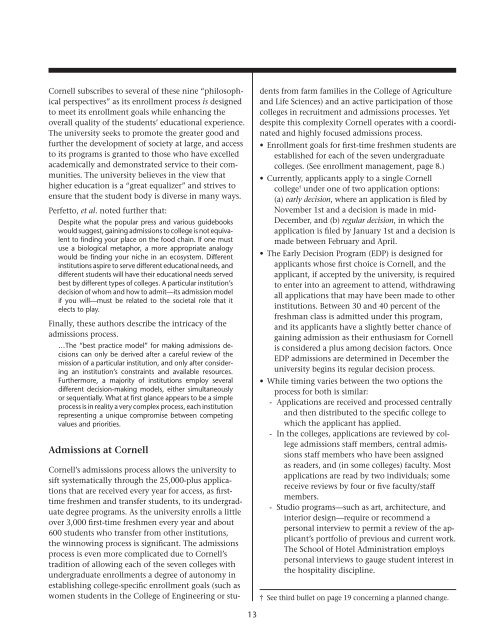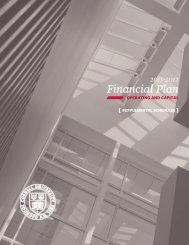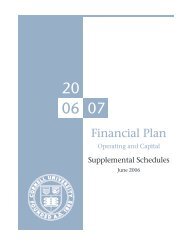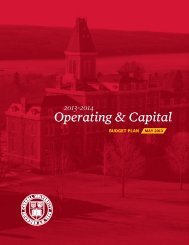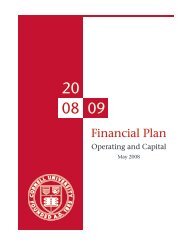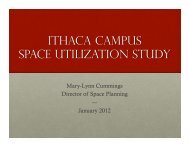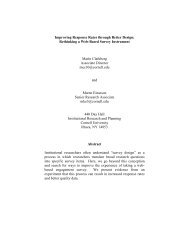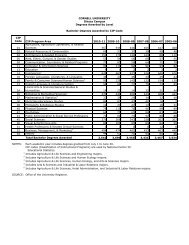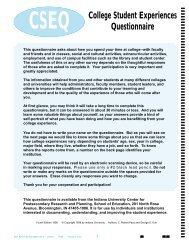Undergraduate Student Access - Cornell University Division of ...
Undergraduate Student Access - Cornell University Division of ...
Undergraduate Student Access - Cornell University Division of ...
You also want an ePaper? Increase the reach of your titles
YUMPU automatically turns print PDFs into web optimized ePapers that Google loves.
<strong>Cornell</strong> subscribes to several <strong>of</strong> these nine “philosophicalperspectives” as its enrollment process is designedto meet its enrollment goals while enhancing theoverall quality <strong>of</strong> the students’ educational experience.The university seeks to promote the greater good andfurther the development <strong>of</strong> society at large, and accessto its programs is granted to those who have excelledacademically and demonstrated service to their communities.The university believes in the view thathigher education is a “great equalizer” and strives toensure that the student body is diverse in many ways.Perfetto, et al. noted further that:Despite what the popular press and various guidebookswould suggest, gaining admissions to college is not equivalentto finding your place on the food chain. If one mustuse a biological metaphor, a more appropriate analogywould be finding your niche in an ecosystem. Differentinstitutions aspire to serve different educational needs, anddifferent students will have their educational needs servedbest by different types <strong>of</strong> colleges. A particular institution’sdecision <strong>of</strong> whom and how to admit—its admission modelif you will—must be related to the societal role that itelects to play.Finally, these authors describe the intricacy <strong>of</strong> theadmissions process.…The “best practice model” for making admissions decisionscan only be derived after a careful review <strong>of</strong> themission <strong>of</strong> a particular institution, and only after consideringan institution’s constraints and available resources.Furthermore, a majority <strong>of</strong> institutions employ severaldifferent decision-making models, either simultaneouslyor sequentially. What at first glance appears to be a simpleprocess is in reality a very complex process, each institutionrepresenting a unique compromise between competingvalues and priorities.Admissions at <strong>Cornell</strong><strong>Cornell</strong>’s admissions process allows the university tosift systematically through the 25,000-plus applicationsthat are received every year for access, as firsttimefreshmen and transfer students, to its undergraduatedegree programs. As the university enrolls a littleover 3,000 first-time freshmen every year and about600 students who transfer from other institutions,the winnowing process is significant. The admissionsprocess is even more complicated due to <strong>Cornell</strong>’stradition <strong>of</strong> allowing each <strong>of</strong> the seven colleges withundergraduate enrollments a degree <strong>of</strong> autonomy inestablishing college-specific enrollment goals (such aswomen students in the College <strong>of</strong> Engineering or studentsfrom farm families in the College <strong>of</strong> Agricultureand Life Sciences) and an active participation <strong>of</strong> thosecolleges in recruitment and admissions processes. Yetdespite this complexity <strong>Cornell</strong> operates with a coordinatedand highly focused admissions process.• Enrollment goals for first-time freshmen students areestablished for each <strong>of</strong> the seven undergraduatecolleges. (See enrollment management, page 8.)• Currently, applicants apply to a single <strong>Cornell</strong>college † under one <strong>of</strong> two application options:(a) early decision, where an application is filed byNovember 1st and a decision is made in mid-December, and (b) regular decision, in which theapplication is filed by January 1st and a decision ismade between February and April.• The Early Decision Program (EDP) is designed forapplicants whose first choice is <strong>Cornell</strong>, and theapplicant, if accepted by the university, is requiredto enter into an agreement to attend, withdrawingall applications that may have been made to otherinstitutions. Between 30 and 40 percent <strong>of</strong> thefreshman class is admitted under this program,and its applicants have a slightly better chance <strong>of</strong>gaining admission as their enthusiasm for <strong>Cornell</strong>is considered a plus among decision factors. OnceEDP admissions are determined in December theuniversity begins its regular decision process.• While timing varies between the two options theprocess for both is similar:- Applications are received and processed centrallyand then distributed to the specific college towhich the applicant has applied.- In the colleges, applications are reviewed by collegeadmissions staff members, central admissionsstaff members who have been assignedas readers, and (in some colleges) faculty. Mostapplications are read by two individuals; somereceive reviews by four or five faculty/staffmembers.- Studio programs—such as art, architecture, andinterior design—require or recommend apersonal interview to permit a review <strong>of</strong> the applicant’sportfolio <strong>of</strong> previous and current work.The School <strong>of</strong> Hotel Administration employspersonal interviews to gauge student interest inthe hospitality discipline.† See third bullet on page 19 concerning a planned change.13


